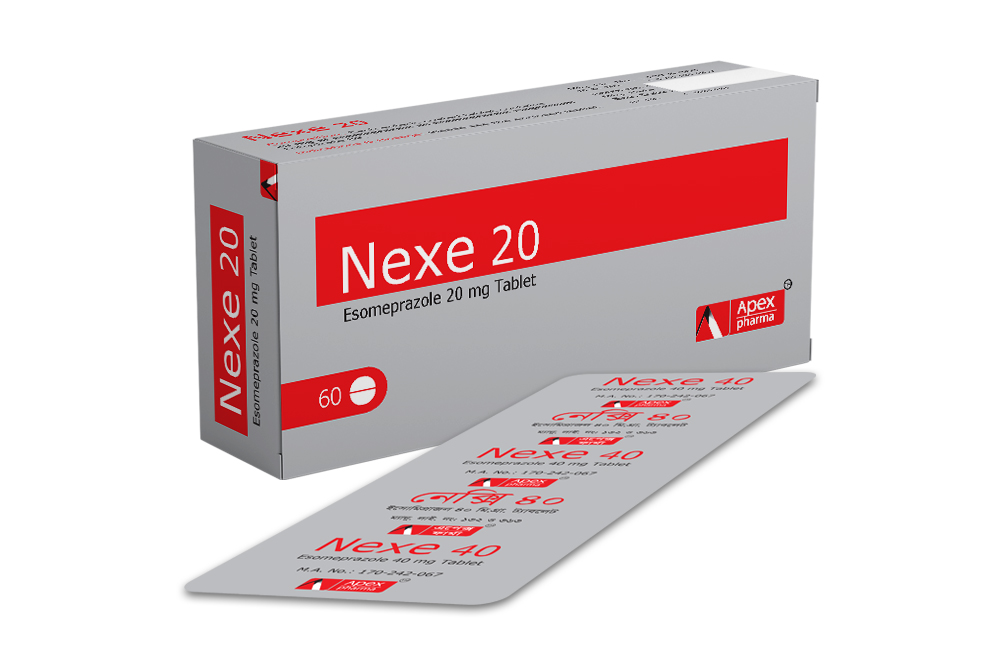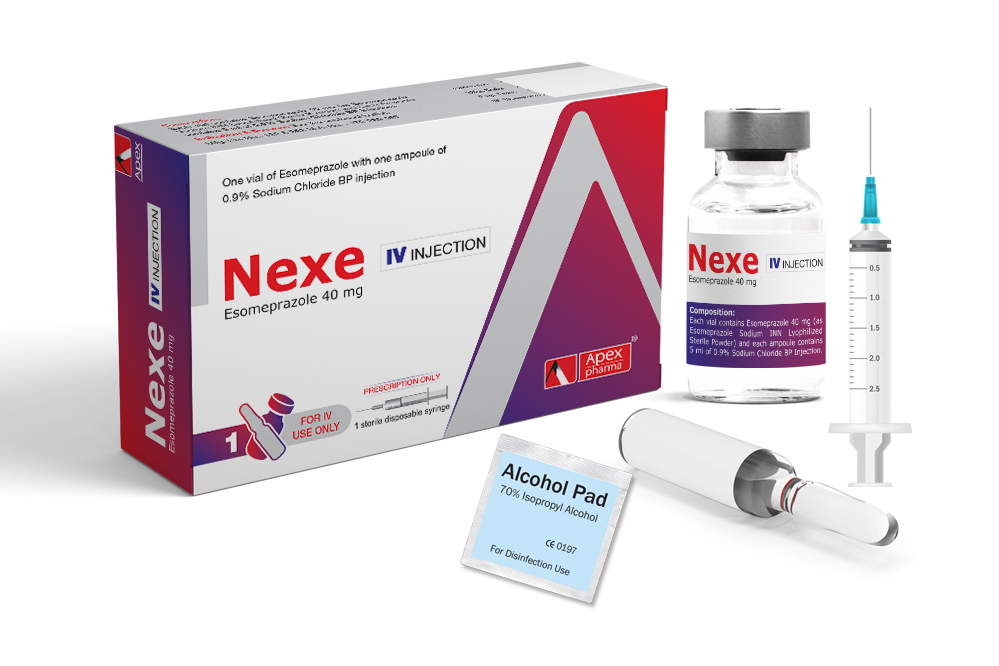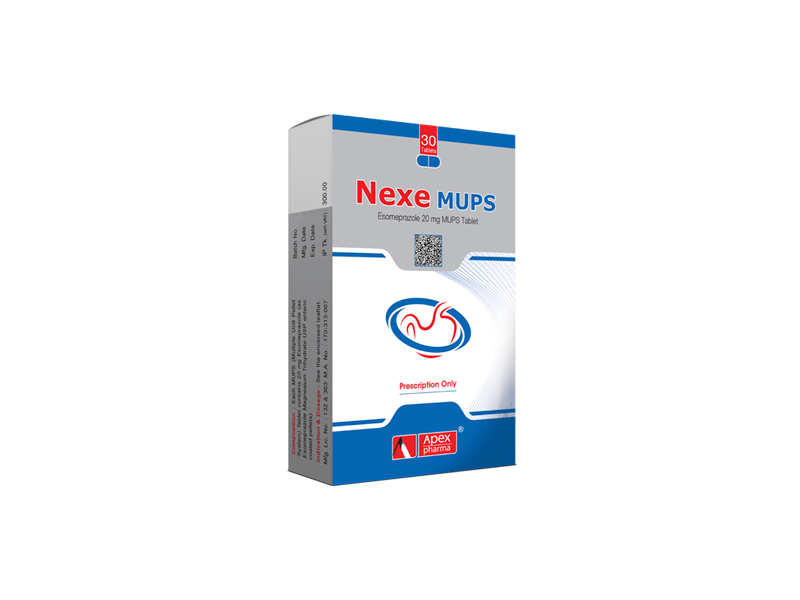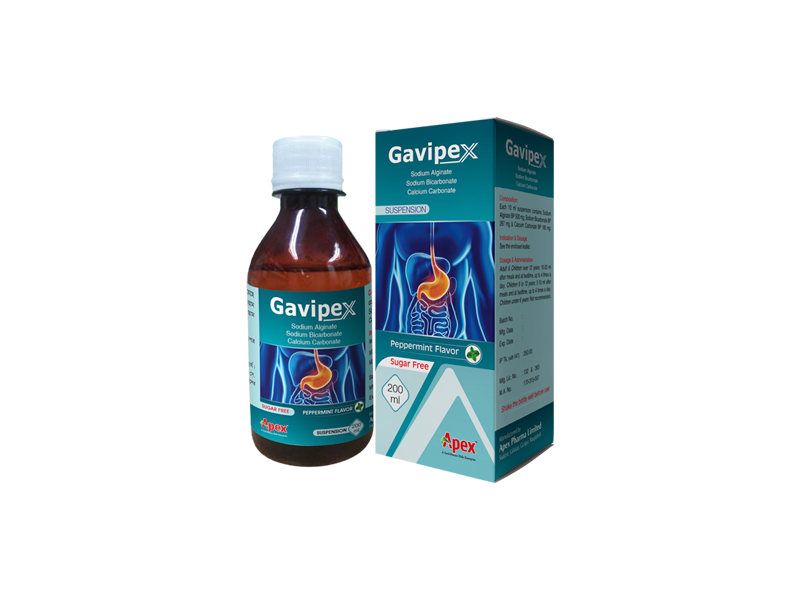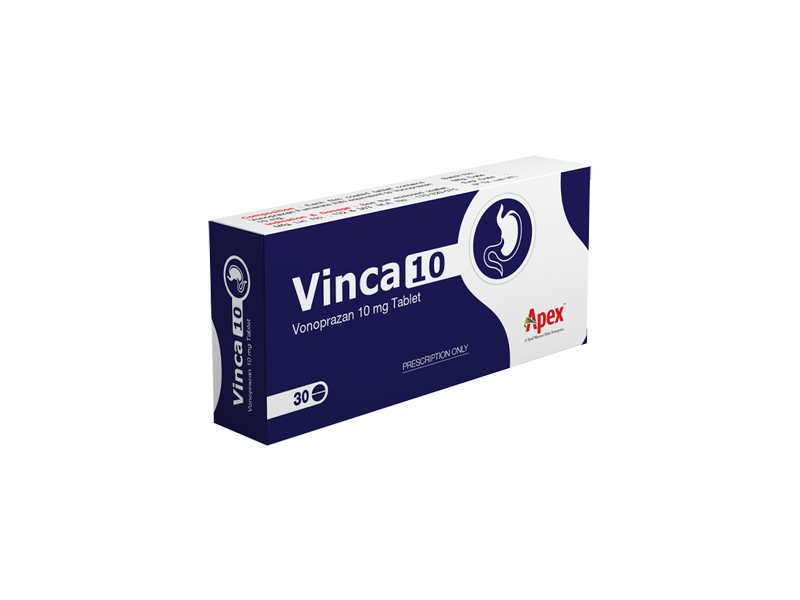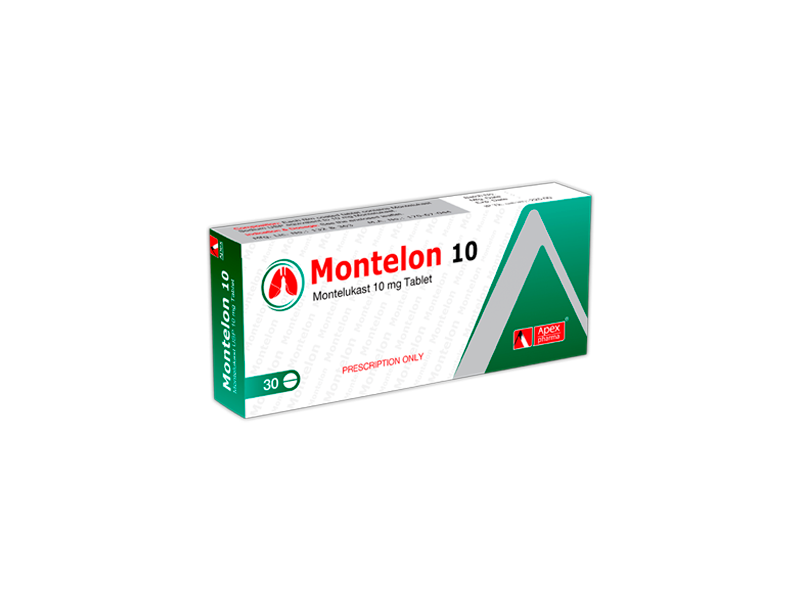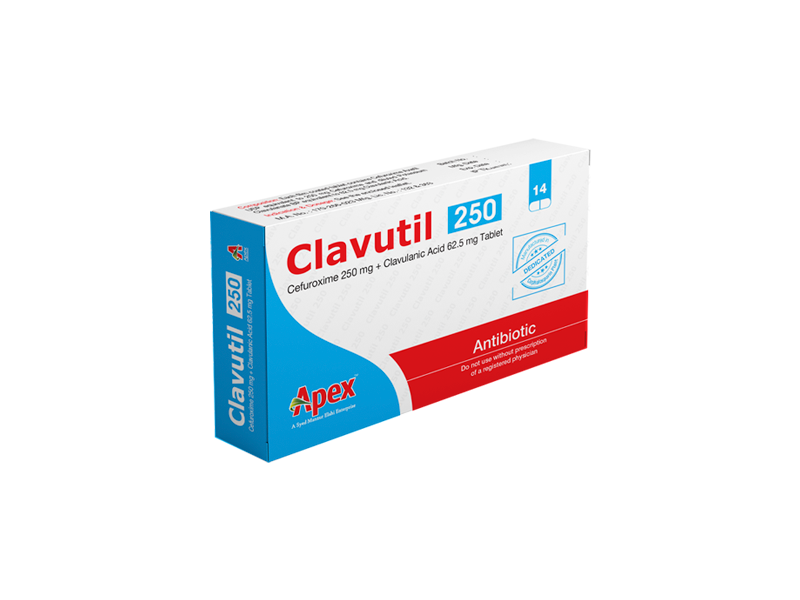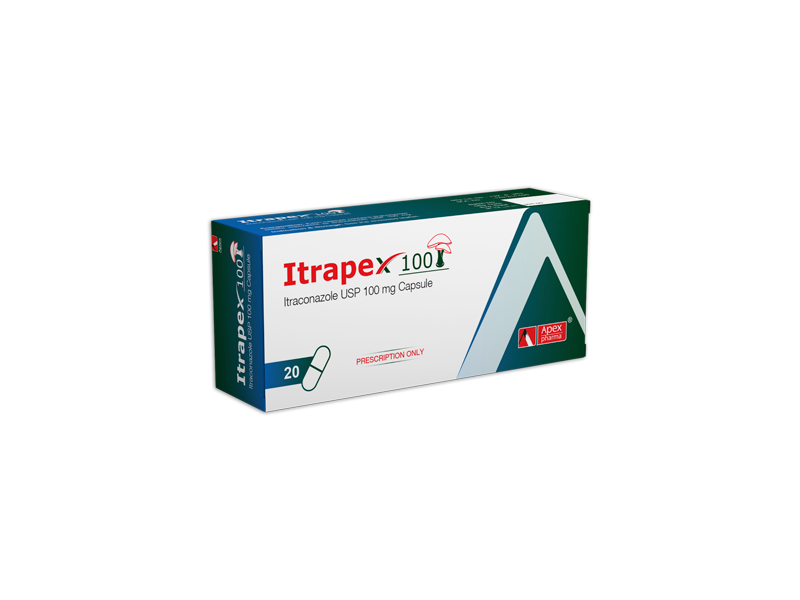
Nexe
Home / By Brand Name / Nexe
Composition
Nexe 20 Tablet: Each enteric coated tablet contains 20 mg of Esomeprazole as Esomeprazole Magnesium Trihydrate BP.
Nexe 40 Tablet: Each enteric coated tablet contains 40 mg of Esomeprazole as Esomeprazole Magnesium Trihydrate BP.
Nexe 20 Capsule: Each capsule contains enteric coated pellets of Esomeprazole Magnesium Trihydrate BP 22.2 mg
equivalent to Esomeprazole 20 mg.
Nexe 40 Capsule: Each capsule contains enteric coated pellets of Esomeprazole Magnesium Trihydrate BP 44.4 mg
equivalent to Esomeprazole 40 mg.
Nexe 40 IV Injection: Each vial contains sterile lyophilized powder of Esomeprazole Sodium INN equivalent to
Esomeprazole 40 mg.
Pharmacology
Esomeprazole (Nexe) is a proton pump inhibitor that suppresses gastric acid secretion by specific inhibition of the
H+/K+ATPase in the gastric parietal cell. By acting specifically on the proton pump, Nexe blocks the final step in acid
production, thus reducing gastric acidity.
Indication
Treatment of Gastroesophageal Reflux Disease (GERD), Healing of Erosive Esophagitis, Maintenance of Healing of
Erosive Esophagitis, Symptomatic Gastroesophageal Reflux Disease, H. pylori eradication to reduce the risk of Duodenal
Ulcer recurrence, Zollinger-Ellison Syndrome, Acid Related Dyspepsia, Duodenal and Gastric Ulcer
Dosage & Administration
Tablet/Capsule/Suspension: The recommended adult dosages are outlined in the table below. Nexe delayed release
tablet/capsule/suspension should be swallowed whole and taken at least one hour before eating.
Recommended Dosage Schedule:
| Indication | Dose | Frequency |
| Gastroesophageal Reflux Disease (GERD) Healing of Erosive Esophagitis | 20 mg or 40 mg | Once Daily for 4 to 8 Weeks* |
| Maintenance of Healing of Erosive Esophagitis | 20 mg | Once Daily |
| Symptomatic Gastroesophageal Reflux Disease | 20 mg | Once Daily for 4 Weeks** |
| Pediatric GERD 12 to 17 Year Olds: Short-term Treatment of GERD 1 to 11 Year Olds+: Short-term Treatment of Symptomatic GERD Healing of Erosive Esophagitis weight <20 kg weight ≥20 kg | 20 mg or 40 mg 10 mg 10 mg 10 mg or 20 mg | Once Daily for up to 8 Weeks Once Daily for up to 8 Weeks Once Daily for 8 Weeks Once Daily for 8 Weeks |
| Risk Reduction of NSAID-Associated Gastric Ulcer | 20 mg or 40 mg | Once Daily for up to 6 months |
| H. pylori eradication to reduce the risk of Duodenal Ulcer recurrence Triple Therapy: Esomeprazole Amoxicillin Clarithromycin | 40 mg 1000 mg 500 mg | Once Daily for 10 Days Twice Daily for 10 Days Twice Daily for 10 Days |
| Pathological Hypersecretory Conditions Including Zollinger-Ellison Syndrome | 40 mg | 40 mg |
*The majority of patients are healed within 4 to 8 weeks. For patients who do not heal after 4-8 weeks, an additional 4-8
weeks of treatment may be considered.
**If symptoms do not resolve completely after 4 weeks, an additional 4 weeks of treatment may be considered.
Injection
GERD with Erosive Esophagitis:
Adults: Dose is either 20 mg or 40 mg Esomeprazole given once daily by intravenous injection (not less than 3 minutes)
or intravenous infusion (10 minutes to 30 minutes).
Pediatric: Give the following doses once daily as an intravenous infusion over 10 minutes to 30 minutes.
1 year to 17 years:
Body weight less than 55 kg: 10 mg
Body weight 55 kg or greater: 20 mg
1 month to less than 1 year of age: 0.5 mg/kg
Directions for reconstitution of solution
Solution for injection is prepared by adding 5 ml of 0.9% Sodium Chloride for intravenous injection into the vial containing
the dry powder. The reconstituted solution for injection is clear and colorless to very slightly yellow.
Administration
IV injection must be administered intravenously over a period of at least 3 minutes. Prepared solution must be used within
12 hours of preparation and can be exposed to normal indoor lighting at a maximum of 30° C.
Geriatric: No dosage adjustment is necessary. Renal Insufficiency: No dosage adjustment is necessary. Hepatic
Insufficiency: No dosage adjustment is necessary in patients with mild to moderate liver impairment. For patients with
severe liver impairment, a dose of 20 mg of Nexe should not be exceeded.
Contraindication
Esomeprazole is contraindicated in patients with known hypersensitivity to any component of the formulation or to
substituted Benzimidazoles.
Precaution
Symptomatic response to therapy with Esomeprazole does not preclude the presence of gastric malignancy. Atrophic
gastritis has been noted occasionally in gastric corpus biopsies from patients treated long-term with omeprazole, of which
Esomeprazole is an enantiomer.
Side Effects
In general, Esomeprazole was well tolerated in both short- and long-term clinical trials. The most frequently occurring
adverse events (>1%) are headache and diarrhea. nausea, flatulence, abdominal pain, constipation and dry mouth
occurred at similar rates among patients taking Esomeprazole.
Use in Pregnancy and Lactation
In Pregnancy: Pregnancy Category C. This drug should be used during pregnancy only if clearly needed.
In Lactation: The excretion of Esomeprazole in milk has not been studied. As Esomeprazole is likely to be excreted in
human milk, a decision should be made whether to discontinue nursing or to discontinue the drug, taking into account the
importance of the drug to the mother.
Drug Interaction
Drug interaction studies have shown that Esomeprazole does not have any clinically significant interactions with
Phenytoin, Warfarin, Quinidine, Clarithromycin or Amoxicillin. Esomeprazole inhibits gastric acid secretion. Therefore,
Esomeprazole may interfere with the absorption of drugs where gastric pH is an important determinant of bioavailability
(eg, Ketoconazole, Iron salts and Digoxin). Coadministration of oral contraceptives, Diazepam, Phenytoin or Quinidine did
not seem to change the pharmacokinetic profile of Esomeprazole.
Overdose
Esomeprazole overdose can lead to drowsiness, vision problems, nausea, sweating, flushing, headache, dry mouth, rapid
heartbeat. Storage Conditions
Keep away from light & moisture and store below 30o C. Keep out of the reach of children.
PRODUCTS

